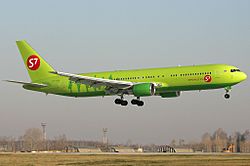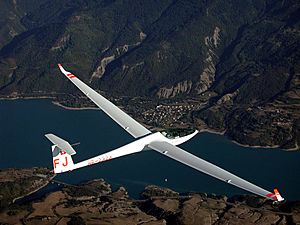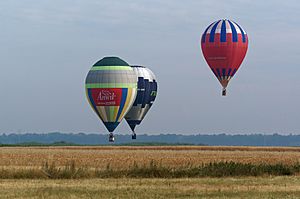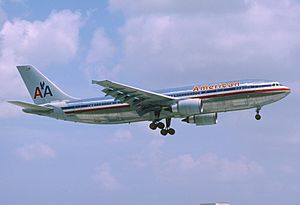Air travel facts for kids
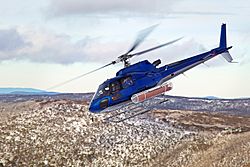
Air travel is a process of going from place to place by any flying object, such as airplanes, helicopters, hot air balloons or anything that can fly.
Air travel has been a very long dream of humans from the ancient age. People seeing birds flying tried to take a flight in many ways and finally came up with balloons and machines that could fly. Air travel has added speed and cut down in travel time drastically. Today we can think of travelling around the world in 24 hours, which was never possible with any other type of transport.
Today air travel is a normal way to travel, for pleasure, personal need or business.
Contents
Domestic and international flights
Air travel can be separated into two general classifications: national/domestic and international flights. Flights from one point to another within the same country are called domestic flights.
Flights from a point in one country to a point within a different country are known as international flights.
Travelers can use domestic or international flights in either private or public travel.
Air travel
Travel class on an airplane is usually split into a two, three or four class model service. US Domestic flights usually have two classes: Economy Class and a Domestic First Class partitioned into cabins.
International flights may have up to four classes: Economy Class; Premium Economy; Business Class or Club Class; and First Class.
Most air travel starts and ends at a commercial airport. The typical procedure is check-in; border control; airport security baggage and passenger check before entering the gate; boarding; flying; and pick-up of luggage and - limited to international flights - another border control at the host country's border.
Environmental effects
Modern aircraft consumes less fuel per person and miles travelled than cars when fully booked. This argument in favor of air travel is counter-weighted by two facts:
- The distances travelled are often significantly larger and will not replace car travel but instead add to it
- Not every flight is booked out
Instead, the scheduled flights are the main focus, resulting in a far worse fuel efficiency.
According to the ATAG, flights produced 781 million tonnes (769 million long tons) of the greenhouse gas CO2 in 2015 globally, as compared to an estimated total of 36 billion tonnes (35 billion long tons) anthropogenic CO2.
Health effects
Deep vein thrombosis (DVT) is the third-most common vascular disease, next to stroke and heart attack. It is estimated that DVT affects one in 5,000 travellers on long flights. Risk increases with exposure to more flights within a short time frame and with increasing duration of flights.
During flight, the aircraft cabin pressure is usually maintained at the equivalent of 6,000–8,000 ft (1,829–2,438 m) above sea level. Most healthy travelers will not notice any effects. However, for travelers with cardiopulmonary diseases (especially those who normally require supplemental oxygen), cerebrovascular disease, anemia, or sickle cell disease, conditions in an aircraft can bring on underlying medical conditions.
Aircraft cabin air is typically dry, usually 10%–20% humidity, which can cause dryness of the mucous membranes of the eyes and airways.
Related pages
Images for kids
-
An S7 Airlines Boeing 767-300ER landing


